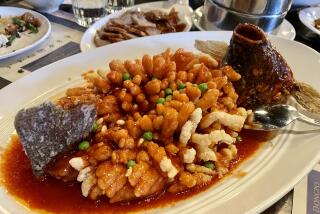Re-Create Traditional Swedish Christmas Feast That’s Truly Fit for a King : Holiday Smorgasbord Makes a Regal Repast
- Share via
For most of us, Christmas is an occasion to be shared with relatives and close friends. In Stockholm, at the 17th Century Royal Palace on the banks of the Baltic Sea, King Carl XVI Gustaf and Queen Silvia preview the holiday with their three children a few days early. On Dec. 19 a holiday meal will be shared with the 150 royal retainers who work in the nine royal palaces. The party is a personal thank you for all who served the family during the year.
The company will gather in the White Sea Gallery, where they will be officially welcomed by the royal family. Lots will be drawn to choose who sits at the king’s table, who will dine with the queen and who will enjoy the regal repast with other members of the family. This decided, the ornately carved doors of the Charles XI Gallery open to the splendid setting of the Christmas feast.
The magnificence of the huge salon is an opulent background. The walls of the gallery are alternating panels of silver- and gold-hued marble. Floral reliefs are gilded with gold leaf. The ceilings are frescoed mythological scenes, and crystal chandeliers beam sparkles over the grandeur.
Fragrance of Pine
The fragrance of pine filters through the room: Two trees have been brought from the grounds of Drottningholm Palace and hold white candles nestled amid the branches.
Twenty-four tables covered in starched damask cloths are set with red linen napkins, heavily garlanded silverware and antique dowry china from Queen Josephine of Poland. Red candles in towering candelabrums illuminate the heirloom goblets waiting to be filled and refilled with aquavit. Pots of Christmas tulips from the royal hothouses adorn each table.
As regal as the surroundings are, the focal point at Christmas luncheon is the smorgasbord table in the center of the hall.
The king’s chef is Werner Voegli, a founding member of Paul Bocuse’s organization, Les Chef des Chefs: chefs to the world’s heads of state, including President Reagan’s. When not creating delicacies for visiting dignitaries at the palace, Voegli is busy in his own kitchen at the Operacelleran Restaurant in the Stockholm Opera House.
Returning for the Next Course
Voegli explains the difference between the Swedish smorgasbord and its foreign cousins by the number of dishes based on salt herring. These are traditionally the first course and are accompanied by warm potatoes, rye crisp bread and a selection of cheeses, notably Edam and caraway, plus a glass or two of cold beer. When the herring has been finished, guests return to the table for the next course. The plate is not supposed to be filled to capacity in one round; too many different foods invariably cause sauces to mingle and confuse the subtleties of each. It is expected that you’ll be going back for more.
After pate and salads comes the main course, which at Christmas is always glazed ham served with red cabbage. In between each course there are toasts of “skoal” and “God jur,” plus interludes for musical chairs before each new course to enable everyone to sit with a new group of merry-makers and to catch up on the year’s happenings.
Somehow, there’s always room for the dessert, a warm and creamy rice pudding. A magical almond is served in one of the portions and entitles the recipient to one wish. If you’re the lucky person you may wish to be in Stockholm next Christmas--if not, you can re-create a Swedish Christmas fit for a king with these recipes.
KING’S FAVORITE SWEDISH HERRING SALAD
1 pound salt herring
2 tablespoons prepared mustard
1 teaspoon dry mustard
1 tablespoon sugar
3 tablespoons oil
3 tablespoons wine vinegar
Salt, white pepper
4 medium potatoes, boiled and chilled
4 large red beets, boiled and chilled
2 medium onions, peeled and diced
1 large apple, peeled and diced
1 pickled gherkin, diced
Chopped hard-cooked egg or whipped cream
Skin and fillet herrings. Rinse well in lukewarm water. Soak fillets overnight in cold water.
Combine prepared mustard, dry mustard, sugar, oil and vinegar in small bowl. Season to taste with salt and white pepper.
Drain herring fillets and dice evenly. Mix with mustard sauce.
Peel potatoes and beets and dice. Place in bowl, then add onions, apple and gherkin. Add herring and toss gently to mix well. Season to taste with salt and white pepper. Refrigerate salad before serving.
To serve, garnish with chopped egg or pipe whipped cream on top. Makes 10 to 12 servings.
JELLIED VEAL
2 pounds veal shank
2 pounds veal neck
2 to 3 quarts water
2 tablespoons salt
1 tablespoon white peppercorns, crushed
4 to 5 sprigs parsley
1 sprig thyme
1 bay leaf
Pickled beets
Bring veal shank, neck and water to boil. Skim surface. Add salt, peppercorns, parsley, thyme and bay leaf. Simmer, covered, 1 1/2 to 2 hours or until meat is tender and easily flakes from bones.
Remove meat from bones and trim off any sinews and membranes. Dice meat. Strain stock, using double cheesecloth, into clean kettle. Add meat and bring to boil.
Pour meat and stock into oblong loaf pans or fluted 2-quart pudding mold, rinsed in cold water. Refrigerate overnight to set. Serve cut in fairly thick slices with pickled beets. Makes 8 servings.
Note: All veal shank may be substituted for veal neck.
MUSTARD-GLAZED YULE HAM
1 whole, half or canned ham, cooked
3 tablespoons prepared mustard
1 tablespoon light corn syrup
1 tablespoon potato flour or cornstarch
1 egg yolk
Dash salt
1/2 cup bread crumbs
Place ham in roasting pan. Remove any skin and excess fat from ham. Combine mustard, corn syrup, potato flour, egg yolk and salt until smooth. Spread evenly on all sides of ham.
Sprinkle bread crumbs over entire ham. Bake at 425 degrees 10 to 15 minutes or until glaze is light yellow. Serve ham hot or cold, allowing 1/4 to 1/3 pound per person for boneless hams and 1/3 to 1/2 pound per person for bone-in hams.
Note: Depending on the size ham chosen, glaze can be doubled or tripled as needed.
RED CABBAGE
(Rodkol)
3 tablespoons butter or margarine
2 pounds red cabbage, shredded
4 apples, diced
3 tablespoons water
6 whole cloves
1 onion, minced
4 crushed black peppercorns
2 tablespoons sugar
2 tablespoons red wine vinegar
Salt
2 tablespoons black currant jelly
Melt butter in saucepan. Add cabbage, apples, water, cloves, onion, peppercorns, sugar, vinegar and salt to taste. Cook about 30 minutes until tender. Serve hot, garnished with black currant jelly. Makes 8 servings.
RICE PUDDING
1 cup rice, well rinsed
Milk
1 tablespoon butter
Dash salt
Sugar
Ground cinnamon
Vanilla or grated lemon peel, optional
1 whole almond, toasted
Warm milk
Combine rice, 1 cup milk, 1 cup water, butter and salt. Simmer over low heat 30 minutes to 1 hour, depending on firmness desired. Occasionally scrape bottom of pot with spatula or spoon to prevent burning, adding milk and water as needed during cooking. Season to taste with sugar, cinnamon and vanilla or lemon peel. Bury almond in pudding and serve with warm milk. Makes 6 servings.
Note: Custom decrees that whoever gets the almond is entitled to one wish for the holidays.
More to Read
Eat your way across L.A.
Get our weekly Tasting Notes newsletter for reviews, news and more.
You may occasionally receive promotional content from the Los Angeles Times.









